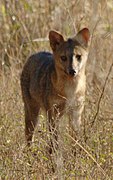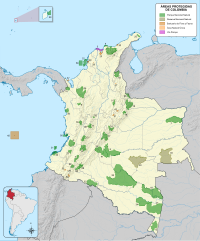Los Estoraques Unique Natural Area

The Los Estoraques Unique Natural Area (Spanish: Área Natural Única Los Estoraques) is one of the smaller national parks, covering only 6 km2 (2.3 sq mi), located in the Cordillera Oriental of Colombia in the Norte de Santander Department. The landscape is shaped by large brownstone pedestals and columns formed by thousands of years of erosion.[1] The area is part of the Catatumbo River basin and elevation range from 1,450 to 1,900 meters above mean sea level. It was declared an Área Natural Única (Unique Natural Area) in 1998.[2]
Geography
The climate is warm and predominantly dry. The average temperature is 22 °C and the average yearly rainfall is 870 mm,[3] with a dry season from January to March. The evapotranspiration is twice that of precipitation, causing a water deficit.
There are two types of plant life in the area, a dry forest with species such as Stachytarpheta mutabilis, Psidium guineense, Erythroxylum lucidum and Dodonaea viscosa and a sub-Andean forest covered in fog most time of the year with species such as Andean oak and horse-chestnut.[3]
The fauna of the region is rich in species, many of them endemic and represented only by small populations which indicates a fragile ecosystem.[4] Birds are the most numerous group of vertebrates, with 58 species in 50 different genus and 22 families.[3] Hunting, deforestation, the introduction of agriculture and domestic animals have limited the number of species and number of individuals per species.[4] Mammals found in the area include the tapeti, jaguarundi, crab-eating fox, and common opossum.
Fauna
-
 Yaguarundí
Yaguarundí -
 Zorro perruno
Zorro perruno -
 Guala cabecirroja
Guala cabecirroja - Tordo
-
 Turpial
Turpial -
 Carriqui
Carriqui
References
- ^ "Área Natural Única Los Estoraques" (in Spanish). Parques Nacionales Naturales de Colombia. Archived from the original on 7 July 2011. Retrieved 10 July 2010.
- ^ Villegas & Sesana 2007, p. 285
- ^ a b c Villegas & Sesana 2007, p. 287
- ^ a b "Naturaleza y Ciencia del Área Natural Única Los Estoraques" (in Spanish). Parques Nacionales Naturales de Colombia. Archived from the original on 7 July 2011. Retrieved 10 July 2010.
Bibliography
- Villegas, Benjamin; Sesana, Laura (2007), Colombia Natural Parks, Villegas Asociados, ISBN 978-958-8156-87-3.
External links
 Media related to Área Natural Única Los Estoraques at Wikimedia Commons
Media related to Área Natural Única Los Estoraques at Wikimedia Commons- (in Spanish) The park's page at Parques Nacionales Naturales de Colombia
- v
- t
- e
- Alto Fragua Indi-Wasi
- Amacayacu
- Bahía Portete
- Cahuinarí
- Catatumbo Barí
- Chingaza
- Corales de Profundidad
- Corales del Rosario y San Bernardo
- Cordillera de los Picachos
- Cueva de los Guácharos
- Doña Juana-Cascabel Volcanic Complex
- El Tuparro
- Farallones de Cali
- Isla Gorgona
- La Paya
- Las Hermosas
- Las Orquídeas
- Los Katíos
- Los Nevados
- Macuira
- Munchique
- Nevado del Huila
- Old Providence McBean Lagoon
- Paramillo
- Pisba
- Puracé
- Río Puré
- Sanquianga
- Selva de Florencia
- Serranía de Chiribiquete
- Serranía de la Macarena
- Serranía de Los Churumbelos Auka-Wasi
- Serranía de los Yariguíes
- Sierra Nevada de Santa Marta
- Sierra Nevada del Cocuy
- Sumapaz
- Tamá
- Tatamá
- Tayrona
- Tinigua
- Uramba Bahía Málaga
- Utría
- Yaigojé Apaporis

- Ciénaga Grande de Santa Marta
- El Corchal "El mono Hernández"
- Galeras
- Guanentá Alto Río Fonce
- Iguaque
- Isla de La Corota
- Los Colorados
- Los Flamencos
- Malpelo
- Otún Quimbaya
- Plantas Medicinales Orito Ingi-Ande
- Playona Acandí
- Nukak
- Puinawai
- Los Estoraques















































